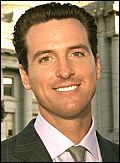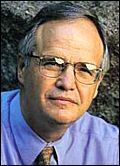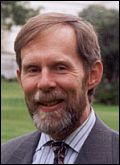
We asked a number of leaders in environment and sustainability issues to imagine they found themselves in an elevator with the president-elect — giving them one minute of his undivided attention. Here are their messages to Obama about how he should approach environment, energy, and climate policy. (For more perspectives, check out Part 2, Part 3, and Part 4 of our elevator-pitch series.)
—–

Gavin Newsom, mayor of San Francisco:
“Where the Bush Administration has failed in the last eight years, you must lead. In your first 100 days, begin implementing a detailed, achievable plan to establish America as the world’s leader in the fight against climate change. By investing in energy independence, you will rebuild the American economy and rid our dependence on foreign oil. Move from the common rhetoric of creating a green revolution in America to achieving results:
“You must:
- Follow-through on your promise to invest $150 billion in clean-technology infrastructure, research, and development (and consider increasing this level of investment). Infrastructure should focus on modernizing our national power grid to make it more efficient and allow new renewable energy projects to feed into that grid. R&D funding should flow to our nation’s universities and scientific institutions to develop new energy-efficiency and renewable-energy technologies, such as ocean power, that can be further advanced through the marketplace.
- Establish aggressive new national efficiency standards for buildings, cars, and appliances. We’ve done this in California over the past two decades and have witnessed no change in per capita energy usage amidst explosive economic growth.
- Recognize the true price of greenhouse-gas pollution by creating an aggressive cap-and-trade system or carbon tax that will make renewable energy competitive with polluting fossil-fuel-burning technologies.
- Organize a bilateral energy summit with China that establishes both countries as leaders in the developed and developing world toward growing national economies while reducing the environmental impact.
- Ensure that clean-energy investment benefits all Americans by creating green-collar job requirements as a pre-condition to any federal funding of infrastructure, research, and development.
- Support cities’ impressive climate protection efforts through technical assistance and resources for programs such as energy-efficiency retrofits in low-income housing.”
—–

Bill McKibben, author, climate activist, and member of Grist’s board of directors:
“Hey, congratulations, or condolences, or whatever’s appropriate. I know you’re focused on that financial meltdown, but it’s the meltdown meltdown that is going to define your two terms in office, Mr. Obama. How you deal with it may be the key to our economic recovery, but even more to the recovery of our stature in the world. We need a deal — but it’s a deal that has to reflect the new crucial piece of information about the planet. According to the scientists at NASA — your scientists, now — that world doesn’t work right above 350 parts per million of CO2 in the atmosphere. Now that you’re done with 270 electoral votes, that’s the number that’s got to focus your thinking.”
—–

Vinod Khosla, Silicon Valley investor:
“Don’t focus on all things green. Instead look at the few things that can achieve 80 percent carbon reductions per mile driven in our transportation fleet and be low-cost enough to penetrate 80 percent of all transportation including in India and China. For electric power, go beyond current renewable fashion. Look at the technologies that can replace or clean up 80 percent of coal-based electric generation with 80 percent lower carbon kilowatt hours!”
—–

Summer Rayne Oakes, eco-activist and model:
“President Obama, we are faced with not only a challenge but an opportunity. You have millions of supporters who are urgently seeking a plan to get this country off of dirty energy and lift millions of hardworking people up by providing clean-energy, green-collar jobs. Bills like the Green Jobs Act need to be fully funded and appropriated; Congressman Edward Markey’s iCAP bill is a shining example of forward-thinking legislation; and even Republicans — including Colin Powell and T. Boone Pickens — are looking for change.
“President Obama, the plans and solutions are here — today. Now we need you to help us make them a reality. I say this not only as the sensible but hard-nosed activist that you see me as today, but as a young girl from Pennsylvania who has seen her single mother struggle in an ailing economy and the very land beneath her feet laid to waste by decades of coal mining. I do not forget where I grew up. I do not take the present for granted. And I sure as hell know that with this knowledge, we can look forward to the future with open eyes. I, too, share in your story of a better America and a better world, but we will not get there if we do not have leadership and force of will. So the question is now, will you be that leader … our leader?”
—–

Gus Speth, dean at the Yale University School of Forestry and Environmental Studies:
“Mr. President, the climate problem is more of a threat to the human future than even many environmentalists realize. You would be well-advised to create a cabinet-level position to lead your efforts nationally and internationally to address it. You should also move quickly to convene a White House meeting of top climate scientists and use that as a springboard to an address to the American people from the Oval Office. You can’t responsibly put this issue off or subsume it under an energy initiative. The most important thing you can accomplish early in your term is major federal climate legislation and a post-Kyoto Protocol international agreement, both aimed at dramatic greenhouse-gas emission reductions.”
—–

Randall Swisher, executive director of the American Wind Energy Association:
“If you really want to make the New Energy Economy a reality, the most important step would be to establish long-term, stable policy in support of renewable energy. That means a long-term extension of the renewable-energy-production tax credit as well as the 25 percent federal renewable-electricity standard by 2025.
“Secondly, our best renewable energy resources — wind, solar, geothermal — tend to be found at a distance from where most people live. To get our renewable energy to electric customers, we will need a significant upgrade of the nation’s transmission infrastructure. But the cost of that investment is cheap compared to the value of all the clean, renewable energy that will be made available to help create new jobs, clean up our environment, and make a substantial down payment in the fight to curb global warming.
“Those two steps — stable long-term policy and transmission infrastructure — are the most important steps to move this country into a position for wind to be able to provide 20 percent of our nation’s electricity by 2030.”
—–

Rick Piltz, director of Climate Science Watch:
“Mr. President-elect, I believe global climatic disruption poses two unprecedented challenges. We must dramatically cut emissions, and we have to prepare for potentially disastrous impacts that are already underway and are projected to intensify in the future. Mobilizing the country to take effective action will require great leadership from your administration and a restoration of integrity in dealing with the findings communicated by the science community. Only when the leadership communicates a clear understanding of the potential dangers will Americans support policies that will adequately reduce emissions and the actions needed to prepare for likely impacts. Couple this with putting in place an ongoing nationwide process to further assess the likely consequences of climate change and opportunities to reduce emissions, and incorporate this knowledge into all relevant spheres of activity. This process should engage citizens all across the country.”
—–

Evon Peter, executive director of Native Movement:
“Barack, as you are aware, our world is in need of deep healing and a transformation of consciousness that will lead to tangible changes in policy and practice, shifting the fundamentally unsustainable and exploitative direction in which we are headed. This is not unlike the years leading up to the end of slavery as ideological forces conflicted and arguments over economics and political structure prevailed. Your presidency will require courageous decisions to face the truth in what is inequitable, unjust, and unsustainable if we are to make needed change happen. Many will vehemently challenge these decisions because they are terrified to face the truth in the situation humanity is facing. Your job is to stay true to principles that the world is in great need of receiving from its leaders. We are entering an era of truth over politics and love over violence as a means to our survival. I wish you blessings in keeping to a solid path and carrying this torch forward.”
—–

Julian Dautremont-Smith, associate director of the Association for the Advancement of Sustainability in Higher Education:
“Higher education has been a leader in helping America overcome many critical challenges and is uniquely positioned to enable the achievement of your goals related to energy, climate, and green jobs. Colleges and universities are eager to help — almost 600 of them have signed a commitment to eliminate their greenhouse-gas emissions and to provide education, research, and outreach to support the transition to sustainability — but they need financial support to meet their potential for leading the sustainability transformation. The Higher Education Opportunity Act of 2008 authorized funds to create a “University Sustainability Grants Program” at the Department of Education, but no funds have been allocated. With your help securing this and other federal support, colleges and universities can mobilize their intellectual resources to break America’s dependence on fossil fuels and create millions of new green jobs at the same time.”
—–

David Foster, executive director of the Blue Green Alliance:
“Our energy, environmental, and economic problems are interdependent. So are the solutions. While there are many ways to stimulate the economy, we don’t need a 20th Century stimulus package. We need a “green recovery” — big, public investments in global warming solutions that put Americans back to work. China is building a coal-fired power plant a week. We need to build 500 megawatts of renewable power a week. Set a goal of creating 2 million new jobs in the next two years with global warming solutions. Then push federal spending down through the states and cities to create massive energy-efficiency programs for our building stock, expansion of mass-transit systems, and a modernized grid to bring our renewables to urban markets. With a green recovery underway and Americans headed back to work, you’ll be able to muster the political will to pass legislation that puts a price on carbon, stabilizes energy prices, and funds the long-term economic transition to a clean-energy economy.”
—–

Terry Kellogg, executive director of 1% For The Planet:
“If you look at the landscape of corporate environmental initiatives, the headlines are impressive. But we are a long way from seeing the kind of change that’s necessary. Despite all the noise, most of the big indicators are still moving in the wrong direction. You should incent companies to show what a new, truly sustainable paradigm looks like. Use today’s ‘best in class’ performers as a guide for setting tomorrow’s baseline. And don’t lose sight of the most important challenge and opportunity: getting the prices right. In getting this stuff done, leverage the wisdom and perspective of the nonprofit sector, and the cover and capacity of corporate leaders.”
—–

Jim Moriarty, president of the Surfrider Foundation:
“Inspire us. Lead us. Challenge us. Your campaign was about these themes and now that you are President we need these more than ever. The United States and its citizens are beaten down. We’ve lost our luster around the world and we’ve lost our sense of optimism. Our environments are red-lining; they are under siege because we’ve lost our collective sense of stewardship. Please look beyond the lobbyists who will anchor us to our past, and challenge every single American to build a new future built on energy independence and environmental stewardship. Do these things with the spirit which compelled us to elect you … your sense of hope and optimism. The most important thing we need from you is your belief in what is possible. Remember that always.”
—–

Michael Crow, president of Arizona State University:
“Renewable energy systems at every level of our economy and at every level of user will be the single most positive thing you can do to address our strategic failures in global economics, global warming, and global politics. This trifecta will renew America’s independence and allow us to focus on the most important issues of education and competitiveness.”
—–
Jonathan Fink, director of the Global Institute of Sustainability at Arizona State University:
“You should view universities as intellectual resources — not just for new research ideas, but for new ideas on how to implement policy. Public universities in large cities have experience in translating research into policy — that’s where the big gap is.
“More specifically, your administration should view urban areas (where most Americans live) as the places where sustainable solutions need to be developed and implemented. The federal government lags way behind the cities and states in experimenting with new sustainability concepts. Direct your agency heads to figure out how best to address the social, environmental, and economic challenges associated with our country’s continuing trend toward urbanization.”


